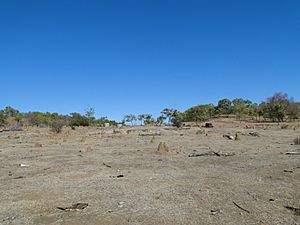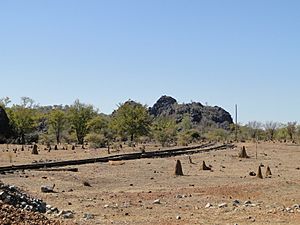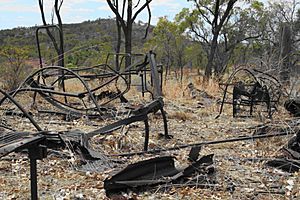Mungana Archaeological Area facts for kids
Quick facts for kids Mungana Archaeological Area |
|
|---|---|

Mungana township site
|
|
| Location | Mungana, Chillagoe, Shire of Mareeba, Queensland, Australia |
| Design period | 1870s–1890s (late 19th century) |
| Official name: Mungana Archaeological Area, Mungana Prospect, Old Mungana Township, Mungana Township, Lady Jane Mine, Eclipse Limeworks and Cemetery, Girofla Mine | |
| Type | archaeological |
| Designated | 11 December 2008 |
| Reference no. | 700001 |
| Significant period | 1880s–1970s |
| Significant components | artefact field |
| Lua error in Module:Location_map at line 420: attempt to index field 'wikibase' (a nil value). | |
The Mungana Archaeological Area is a special place in Queensland, Australia. It's where an old mining town called Mungana used to be. Today, you can still see the remains of mines, buildings, and other things from when people lived and worked there.
This area is also known by other names like Mungana Prospect, Old Mungana Township, Mungana Township, Lady Jane Mine, Eclipse Limeworks and Cemetery, and Girofla Mine. It was added to the Queensland Heritage Register in 2008 because it's an important part of history.
History of Mungana
The Mungana area shows us what was left behind from mining and town life. This all started during Queensland's big mining boom in the 1880s. The area was closely linked to the nearby town of Chillagoe.
Early Days and Mining Beginnings
Chillagoe was first settled in 1887 by William Atherton. He built a large home there in 1888. His plan was to supply beef to the growing mining operations.
A rich mining boss named John Moffat visited the area in 1888. He heard about valuable minerals being found. Moffat then bought the rights to mine in a large part of the Chillagoe and Mungana area. He started smaller mines, including a metal processing plant (called a smelter) at Calcifer in 1894.
Mining in Mungana officially began in 1893-1894. John Moffat hired 70 men to look for minerals at a place called the Girofla lode (a rich vein of ore). Big mining operations started in 1896. Moffat had 20 men dig a mine shaft at Girofla. They also built a dam and a place for a smelter.
A temporary town, mostly made of tents, quickly grew near the mine. It was also called Girofla. Soon, the settlement had a few buildings, including three hotels. By 1897, the population had grown to 158 people. The Girofla smelter mainly processed lead and silver. It also handled ore from other nearby mines Moffat owned, like the Griffith, Dorothy, Red Dome, and Lady Jane mines.
Growth of the Town and Railway
As mining grew, John Moffat and his business partner, James Smith Reid, wanted to organize their mines better. They also needed money to build more things. They first created the Chillagoe Proprietary Company. This company bought Moffat's mining leases. They also talked with the government.
By late 1897, a law was passed to build a private railway. This railway would connect Mareeba to Chillagoe. The company also got a large area of mineral leases. The government agreed not to require a certain number of workers at the mines. A new company was then formed called the Chillagoe Railway and Mines Limited.
They started building the railway and a new, larger smelter. The smelter was eventually built in Chillagoe (Chillagoe smelters). As the railway was almost finished in 1901, Moffat and Reid made the Mungana mines a separate company. This new company was called the Mungana (Chillagoe) Mining Co. Ltd. It included the Girofla, Lady Jane, Griffith, and Dorothy mines.
When the railway reached Mungana in 1901, it changed the town a lot. The town moved from its first spot near the Girofla mine. It moved to a new area on both sides of the railway line. The town was officially renamed Mungana. The Girofla smelter closed in 1902. This was because ore could now be easily sent by train to the big new smelter in Chillagoe.
The new town of Mungana quickly grew. It had a cricket club, a horse racing club, a court house, a library, and a reading room. At its busiest in 1920, Mungana had six hotels, three stores, a bakery, a butcher, a candy shop, a clothing store, a post office, a church, a school, and a stable.
Transport and Challenges
At the end of the railway line, a stone wall was built in 1902. This was for the OK Copper Mines Development Syndicate NL. The OK Mine, smelter, and town were north of Mungana. They used Mungana's new railway to get supplies. They unloaded coke (for their smelter) and goods for their town. They also loaded refined copper to send away.
At first, horses carried things from Mungana to OK. But in 1905, the OK Company started using 400 camels. These were managed by Abdul Wade's "Bourke Carrying Company." Within months, Abdul Wade replaced the camels with traction engines (steam-powered vehicles). This was because camels were too expensive to feed. The six traction engines could each pull eight tons. They cost £7,000. The stone wall was still used in 1913. Even after the OK smelters closed, miners brought their ore to Mungana to be sent by train to the Chillagoe smelters.
Mungana kept growing despite money problems with the main Chillagoe company. The Lady Jane Mine looked promising. In 1909, new equipment was added. The Mungana Mining Co. put in a large pumping system at Girofla in 1911. This was one of the biggest in Queensland at the time. It needed a lot of support structures.
A formal cemetery was started about two kilometers from town. It had both marked and unmarked graves. The oldest known burial was in 1904. The town's racetrack was also in this area. One of the cemetery fence posts was even a marker for the fourth furlong (a distance in horse racing).
Decline and Legacy
Even with new equipment, the Mungana Company struggled. An underground fire in 1909 partly closed the Lady Jane mine. This meant a lot of valuable ore was lost. The whole Mungana Company went out of business by 1914. All the mines closed. The Lady Jane mine filled completely with water.
The Chillagoe Company bought the Mungana operations. However, the Chillagoe Company was also having money problems. The Mungana mines stayed closed until the Queensland Government bought them in 1919.
When the government took over in 1919, they reopened the Girofla and Lady Jane Mines. This time was the town's busiest period. However, it also became part of a big political event.
In 1926, the mines closed again. Questions were raised about how much the government had spent on the mines. This event became known as the Mungana affair. A new government led to an official investigation in 1930. This investigation looked into the purchase of the mines. While the people involved were later cleared of serious charges, the Mungana Affair ended their political careers.
The Chillagoe Smelters continued to be important for mining in the area. But by 1943, there wasn't enough valuable ore. Also, many workers left to serve in World War II. This led to the smelters closing for good.
After the mines closed, Mungana continued as a service center. It was also a place where cattle were loaded onto trains. Cattle farming had grown since the Atherton family started Chillagoe station in 1886. The Mungana cattle yards served local farmers. They also helped stations from the Gulf and Lower Cape York Peninsula. Water for the cattle was always a problem, especially after mining stopped.
Regular train services to Mungana stopped in 1958. Trains only went past Chillagoe when cattle needed to be moved. The end of train services was the final blow for Mungana. By 1959, the town had shrunk to just a hotel, a store, a post office, and seven residents.
New metal cattle yards for road transport were built in the 1970s. The old wooden cattle yards fell apart. Today, the Mungana Township is completely empty. It has become a place for tourists to visit. Some mining is starting again in parts of the area. A new zinc mine is being built.
The powder magazine (for explosives) and detonator shed are the only old buildings still standing. But you can still see many remains of the railway, old building foundations, cattle yards, mining operations, and the cemetery.
In 2016, the area became part of the Chillagoe mine project.
What You Can See at Mungana Today
The Mungana Archaeological Area covers about 6.5 square kilometers. It has eight main parts.
Mungana Cemetery
This cemetery started in the early 1900s. It's located away from the main town, on the north side of the Burke Developmental Road. Only a few graves have clear headstones. But you can see signs of many other graves, like old grave decorations and dips in the ground. A wire fence marks the area, and the entrance gate has a sign.
The Main Township and Cattle Yards
This is the biggest part of the area. It's just south of the Burke Developmental Road. Here you can find many things. These include the Eclipse Quarry and Lime Kiln, the railway line and its raised path, and what's left of homes and shops. You can also see the second school, the cattle railway siding, and the cattle yards.
Some areas are covered in thick plants, hiding historical features. The cattle yards are damaged by termites, rot, and fire. But the strong wooden fences that are left can still tell us a lot. The site also has a concrete spray race (for treating cattle) and a concrete slab where a building once stood. The railway line is still there, along with other railway parts like a signal light. However, the tracks right next to the yards are badly eroded.
The Hospital
This site is on top of a hill south of the main town. You can still see parts of the hospital building, like concrete drains and wooden posts. Many old items are also found here, such as bed frames, kerosene tins, and a bath.
Girofla Mine
This mine site is west of the hospital. It's right next to the southern side of the Mungana Branch Railway Line. The site includes the main mine shaft. You can also see parts of the pump arm, a large brick and concrete tank stand, wooden posts, many concrete foundations, pipes, and a fallen metal chimney. The area has natural features like a large limestone hill above the main shaft where machines were placed. It also has human-made features like large piles of waste rock (mullock heaps). The main mine shaft area is fenced off for safety.
Girofla Smelter
This area is south of the Girofla Mine, at the bottom of a steep ridge. It has strong foundations, a stone wall, waste from the smelting process (slag spoil), and remains of homes. A ruined home is on a hill south of the smelter. It has a stone foundation with a thin concrete floor. Next to the floor is a large dip in the ground, likely for collecting water. You can find small pieces of old bottles and pottery around the house area.
Lady Jane Mine
This is another large and complex area. It's east of the Girofla Smelter, next to the modern road to Red-Dome. It has both mining and home features. The large main shaft is right next to the road and is fenced off for safety. Around the shaft, you can find many mining items and features. These include machine foundations, metal pipes, and an old tramway with wooden sleepers. There are also kerosene tins and many bricks. To the southwest of the mine shaft are two ruined homes. These have small amounts of old items scattered around. The eastern home has a frangipani tree next to its concrete floor. This home is also near large U-shaped concrete foundations for winding machinery.
Old Mungana or Girofla Township
This site is north of the Lady Jane Mine, across the modern road. It has many features and scattered items from the early town. The items include pottery and glass. They date from the late 1800s to the mid-1930s. This suggests people might have kept using this area for a long time, even after the town officially moved in 1901.
Mungana Magazines and Access Route
These are located inside the Chillagoe-Mungana Caves National Park. They are north of the old Mungana/Girofla Township. This area has the only buildings still standing in the archaeological area. There are two storage buildings (magazines) of different sizes, right next to each other. The smaller one was used for storing detonators (parts that set off explosives). The larger building was for storing explosives.
Both buildings look similar. They have corrugated iron roofs that come to a point (gabled roof) and white-painted outside walls. They are built from hollow blocks, which people think were made locally. The missing roof on the explosives magazine was replaced in 2000 with a new metal roof. The magazines are away from the old town, hidden behind some limestone hills. You can reach them by a road between two of these hills. The road still shows marks from the blasting and drilling needed to build it.
Why Mungana is Important
The Mungana Archaeological Area was listed on the Queensland Heritage Register in 2008. It's important for several reasons:
- Showing Mining History: It helps us understand how the mining industry helped develop far north Queensland. It shows how non-Indigenous people settled the area. The town was busiest when John Moffat's company and later the government ran the mines. Even after mining, it continued to support the cattle industry for another fifty years.
- A Key Railway Town: The old Mungana Township and its railway station are important in Queensland's history. They were a major part of the Chillagoe Mineral Field. The railway line from Mareeba to Mungana was a rare successful partnership between the government and a private company for building railways between 1860 and 1900. The Girofla and Lady Jane Mines were big operations. They were a key part of the network that supplied ore to the Chillagoe Smelters. The large pumping system at the Girofla Mine in 1911 was one of the biggest in Queensland. It was a big effort to deal with the water problems in the mines.
- Learning from the Past: Not many old records exist about Mungana. But what's left in the ground (the archaeological record) can help us learn a lot about Queensland's history. It's a rare chance to study a whole community from its beginning to its end. All parts of the town and mining operations still exist in some form. We can find old foundations, railway lines, pipes, rubbish dumps, home remains, a lime kiln, explosives stores, roads, a cemetery, a school, wells, a hospital site, cattle yards, and places like hotels. Even though some parts have been disturbed, the large size and isolated location of the site mean that most of it is still well-preserved.
- Understanding Community Life: The Mungana Archaeological Area can help us answer important questions about how the community grew, how people interacted, traded, and survived. Studying the physical remains can tell us much more about the town's history and the lives of its people. For example, early studies show that even though the town officially moved in 1901, people might have kept living in the old Girofla area until the 1930s.
- Comparing with Other Towns: This area can help us learn about what life was like for isolated mining communities in far north Queensland in the late 1800s and early 1900s. There are many abandoned mining towns in Queensland. The items and potential buried remains at Mungana are a great way to compare it with other towns. This helps us better understand how people lived and worked in such communities.
- More Research Potential: The Mungana Archaeological Area can also help us learn more about Queensland's history. This includes questions about different groups of people, social classes, population changes, health, industries, worker movements, and entertainment. We can even compare what happened during the times when the mines were privately owned versus when they were owned by the state government.




